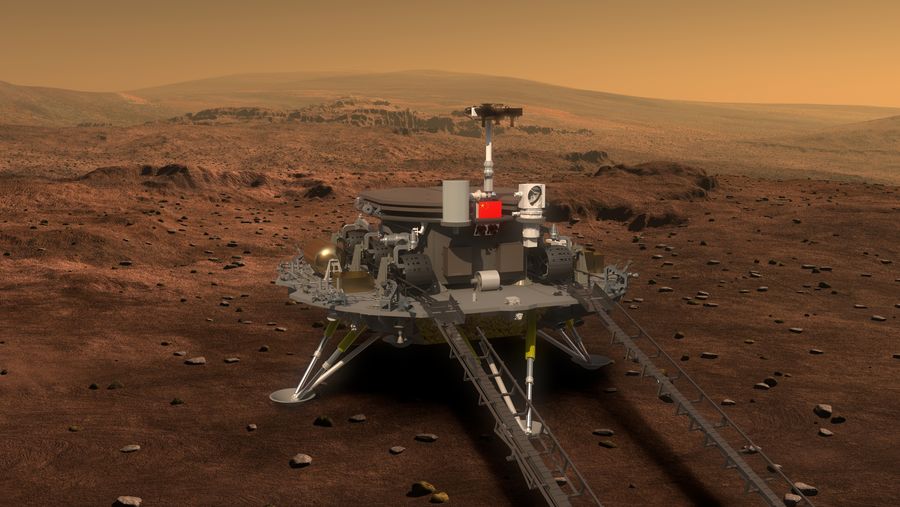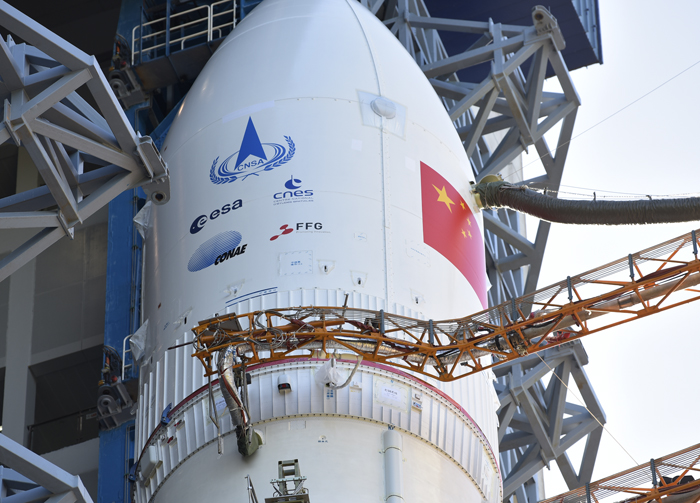China's first Mars rover Tianwen-1 launches this week. Here's what it will do.
A new paper lays out key details about the historic mission.
China's Mars rover will likely attempt to land at a site in northeastern Mars, according to a new paper published just days ahead of the mission's launch.
The paper, which was published last week in the journal Nature Astronomy, was written by team members of China's Tianwen-1 Mars mission, which aims to send an orbiter and a lander/rover duo to the Red Planet.
The study reveals new details about Tianwen-1, outlining its intended landing area, science goals and the names of instruments aboard the spacecraft. It also stresses the historic nature of the mission: Not only is Tianwen-1 China's first fully homegrown Mars mission, it's also the first to carry both a planetary orbiter and a rover. (China's first Mars craft of any kind, an orbiter called Yinghuo-1, launched on a Russian rocket along with Russia's Phobos-Grunt mission in November 2011. The launch failed, and all the spacecraft aboard eventually fell back to Earth.)
Related: This is the 1st photo of China's Mars explorer launching in 2020

Tianwen-1 means "questions to heaven" and was taken from the title of a poem by Qu Yuan (340-278 BCE). The mission is expected to launch on a Long March 5 rocket in late July or early August from Wenchang on Hainan Island, according to the paper. Current unofficial estimates suggest a launch around July 23.
The spacecraft will reach Mars in February 2021, at the same time as NASA's Perseverance rover and the United Arab Emirates' Hope orbiter, which launched on Sunday (July 19). However, China's rover will remain attached to the orbiter for two to three months before attempting its landing, according to the paper.
The chosen landing area is Utopia Planitia, a huge basin formed by a large impact far back in Mars' history that was also the region where NASA's Viking 2 lander touched down in 1976. According to areas defined in earlier statements on landing areas, China had isolated a portion of the vast plain as a candidate landing area, running from Isidis Planitia to the big volcano Elysium Mons.
Get the Space.com Newsletter
Breaking space news, the latest updates on rocket launches, skywatching events and more!

The low elevation of the area means there will be more time and atmosphere for the entry spacecraft to slow down and safely descend to the surface. The latitude, between roughly 20 and 30 degrees north, is also suitable for receiving enough sunlight to power the roughly 530-lb. (240 kilograms) rover. The relatively smooth surface will also be conducive for roving. The mission also benefits from the engineering heritage of China's Chang'e lunar exploration program, the paper noted.
The rover is expected to be in operation for about 90 Martian days, or sols, and is nearly twice the mass of China's Yutu-2 rover, which is currently in its 20th lunar day on the far side of the moon. The Tianwen-1 orbiter will provide a relay communication link to the rover while performing its own scientific observations for one Martian year, according to the paper. (One sol is about 40 minutes longer than an Earth day. One Martian year is 687 Earth days.)
The orbiter will operate in a polar orbit in order to map Mars' morphology and geological structure while also using the Mars-Orbiting Subsurface Exploration Radar instrument to investigate soil characteristics and water-ice distribution. It will also measure the ionosphere and the electromagnetic and gravitational fields, the new paper reported.
The rover will investigate the surface soil characteristics and water-ice distribution with its own Subsurface Exploration Radar. It will also analyze surface material composition and characteristics of the Martian climate and environment on the surface.
One of the paper's authors was Wan Weixing, the chief scientist for Tianwen-1. Wan died in May, just a couple of months before the coming launch. He is described as a world-leading space scientist and a pioneer in China's planetary science program in an obituary published last month, also by Nature Astronomy. His given name, Weixing, literally means "satellite."
As well as detailing his career in space, science and academia, the obituary gives insight into Wan's other interests. He often stayed up late to watch English Premier League or Italian Serie A soccer matches, sometimes causing him trouble in getting to academic meetings the next morning, obituary author Yong Wei recalls.
Follow us on Twitter @Spacedotcom and on Facebook.
Join our Space Forums to keep talking space on the latest missions, night sky and more! And if you have a news tip, correction or comment, let us know at: community@space.com.

Andrew is a freelance space journalist with a focus on reporting on China's rapidly growing space sector. He began writing for Space.com in 2019 and writes for SpaceNews, IEEE Spectrum, National Geographic, Sky & Telescope, New Scientist and others. Andrew first caught the space bug when, as a youngster, he saw Voyager images of other worlds in our solar system for the first time. Away from space, Andrew enjoys trail running in the forests of Finland. You can follow him on Twitter @AJ_FI.









